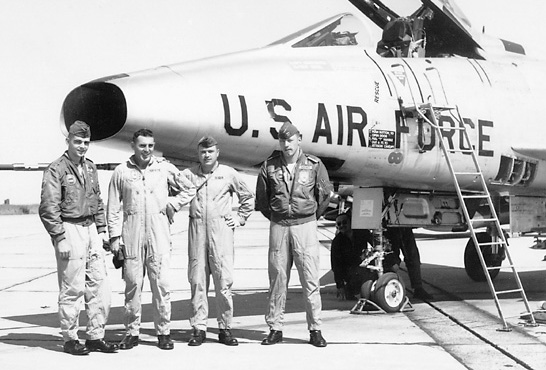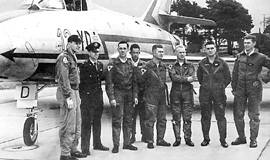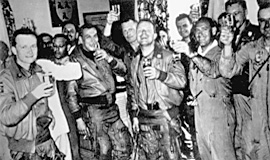
When 74 squadron first re-equipped with the Lightning in 1960, its CO, John Howe, had been well aware of the US Air Force Tigers at Woodbridge, the 79th TFS of the 20TFW. Correspondence between the two units had been going on since the first contacts had been established a few years before, and occasionally a social meeting was arranged. On impulse, John picked up the phone to speak to his counterpart at the Suffolk base, perhaps with a subconscious idea to set the ball rolling on some sort of operational exchange rather than a purely social one so that 74 could show off their new mount. What he was not aware of at that time was that an old friend of his, Ed Rackham, had just taken command of the 79th TFS. Their meeting again after almost ten years prompted the idea of the two squadrons getting together on a regular operational basis. In 1962 the Tiger Meet was a much bigger affair and eight squadron were represented; the credit to this goes again to Mike Dugan (future CofS USAF), who had spent a large part of his time identifying Tiger Squadrons in all the European and European Based Air Forces.

74 was heavily involved in the workup for Farnborough at the time and, sadly, this commitment allowed the squadron to send only officers to observe and to participate in the social activities, although, as we have seen, it was able to display the lightning at the end of the Meet. Activity was not confined to the air, for apart from a full flying program, a series of conferences was held which dealt with a variety of problems and activities within the sphere of NATO operations. Social aspects were also not overlooked. Receptions and dinners were organised for air as well as ground crews; and at the final banquet the guest of honor was General Anderson, the SHAPE Air Deputy, who by his very presence underlined the importance of the Tiger Meet in the eyes of the highest command. In his speech, General Anderson put into words for perhaps the first time the underlying aims and objectives of the Meet - The promotion of NATO solidarity, the achievement and maintenance of firmer professional relationships amongst NATO personnel and the creation of better understanding of NATO military objectives and the problems of NATO partners. These objectives remain as valid today as they did 53 years ago.

(note: We checked the authenticity of this story with General Dugan and he said “this is not exactly what happened”. But we thought “why let facts get in the way of a good story”, so we’ll keep it here so it doesn’t get lost.)
The story below was found amongst some old papers from the 79 TFS.
Although the origin of Tiger Meet is a bit fuzzy, it appears to have started with the 79th and No 74 squadron RAF getting together for some whiskey and cheer in 1960. In 1961 the meeting was continued, with the addition of the French EC 1/12, and so the NATO Tiger Association was born. In 1962 then Lt Mike Dugan volunteered as project officer. Lt Dugan, never one to let authority corrupt fighter pilot activities, decided it should be a true “NATO Tiger Day“. He therefore sent letters directly to all the tigers for which he found an address. A number of units immediately accepted but returned their reply “through channels “. This of course resulted in all the HQs (USAFE, 3rd AF, and the 20th Wing) descending on the 79th with “requests” as to what the hell we thought we were doing. Mike’s program won the Wing Commander’s support and they, in turn convinced Head Quarters that NATO Tigers was possible. About this same time a London paper headlined an article, “IRON CROSSES OVER SUFFOLK” or something close. I then got a call from an RAF friend at Fighter Command.

It was a “friendly consultation” about “Yank” ignorance. It seems that at that time no German military aircraft were allowed near the UK. He had just spent the day un-ruffling the feathers of the Prime Minister’s press office. He’d indicated to the PR boys that both the RAF and other NATO forces were involved and a refusal of the German forces would be difficult. The result was a limited and somewhat miffed consent. USAFE also approved with file usual admonition that nothing bad better happen. After such a bumpy start, Mike’s planning and drive got everything on track and with the help of a world of people it became a success. A couple of other events coloured that gathering. We had a motley assortment of tiger emblems, but the spirit was there. The French brought a large transport loaded with ammo boxes for the various competitions. When opened, most of the boxes contained champagne! The Biggin Hill 'Tiger Moth Club” almost invited themselves. This turned out to be a lucky move, since weather on the flyby day was about 400 ft. in heavy rain. Not to be discouraged -the Moths took off in flights of three and four to do flybys and low level acrobatics. A weird day.
We don ’t know the author of that piece, but we do know that Mike Dugan went on to become a four star general and chief of staff, USAF. The moral of the story is obvious. Squadron level enthusiasm, planning, and the ability to get things done (with the kind assistance and authorization of HQ) leads to success. Tiger spirit has been a key ingredient throughout our history.